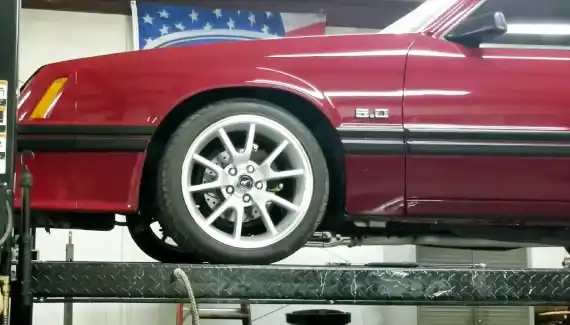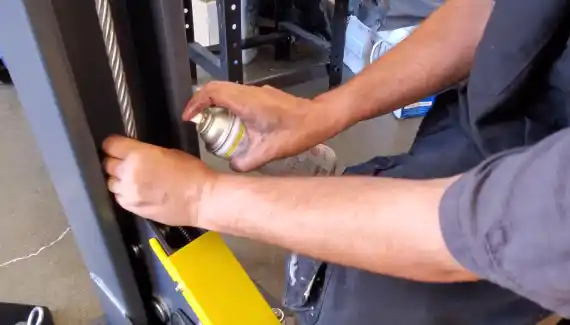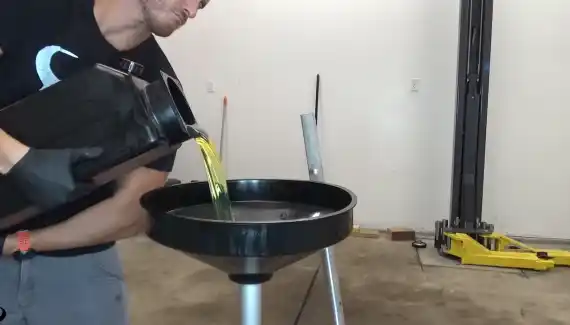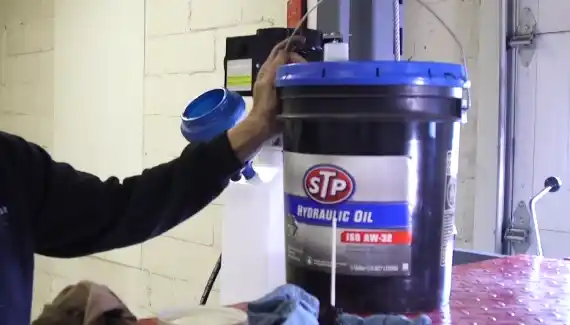Last Updated on February 28, 2023
Proper lubrication of a four post car lift is an essential part of its maintenance. Lubricants should be applied according to the manufacturer’s specifications while cleaning and preparing the lift beforehand.
The lubrication process includes lubricating cable sheaves, adding new oil and lubricating moving parts, anchor bolts & other hardware. Regularly changing fluids will ensure that the lift remains efficient and runs smoothly, as well as protect against rust and corrosion.
Failure to adequately lubricate the lift can result in reduced performance or even damage to components. Safe, efficient operation of your four post car lift is just a few steps away. Let’s take a look at the lubrication instructions and ensure it continues running smoothly.
How To Lubricate A Four Post Car Lift Safely: Complete Instructions

Lubrication is an essential part of maintaining a four-post car lift. Since these lifts are used to raise vehicles in a home garage and professional workshop, follow the proper lubrication steps to keep them running smoothly and safely. Check the owner’s manual to see the recommended lubricant type before applying.
Step 1: Inspect the Lift
Before beginning any maintenance, inspect the lift for any signs of wear or damage that may have occurred since its last service. Ensure all bolts, screws, and nuts are securely tightened and check for visible signs of corrosion or rusting.
Step 2: Clean and Prepare the Lift
Use a soft cloth or brush to clean off any dirt or debris from the surfaces of the lift, paying special attention to cable sheaves and cables. Ensure all parts are free from dust, grime, grease, or other foreign objects before lubrication.
Step 3: Raising Platforms and Axle Stands onto 1st Level of Posts
The first step in lubricating your four-post car lift is to raise the platforms onto the first level of posts. This can be done manually with a lever or by using an electric winch if one is available. Ensure that all parts are secure and stable before proceeding to the next step.
Step 4: Lubricate Cable Sheaves
Using an aerosol lubricant such as WD-40 or red lithium grease, spray generous amounts into each cable sheave bore and cable sheave pin until they become saturated with the product. This helps protect against friction while ensuring that cables slide smoothly across their surfaces.
Step 5: Opening Drain Plugs on Hydraulic Cylinders
The second step involves opening up the drain plugs located on each hydraulic cylinder on the lift’s post stands. These plugs should be unscrewed so that any old oil or lubricant can be drained out from the cylinders, which helps prevent any build-up from occurring inside them.
Step 6: Adding New Oil

After draining out any old fluid, it’s time to add new oil or lubricant into the cylinders of your 4 post lift. Choose an appropriate oil that corresponds with your vehicle type and use it when pouring it into each cylinder until they are all full.
If you’re unsure which type of oil to use, check with your local automotive shop for assistance in selecting the right product for your needs.
Step 7: Filling Oil Reservoir
Once all cylinders have been filled with new oil or lubricant, move on to filling up the reservoir located within your four post car lift platform station with appropriate fluids.
Ensure not to overfill it, as this could lead to excessive pressure building up inside the system and potentially cause damage to its components over time if left unchecked.
Step 8: Lubricate Moving Parts
Apply red lithium grease or a similar product onto all moving parts on the lift. It includes crankshafts and rubbing surface areas such as columns where slide blocks glide/locking blocks contact each other.
When cleaning your car lift chains, lower the lift sufficiently beforehand so that no pressure is placed on them during the cleaning process. Once you have lowered the car lift, spray the chains with a lubricant. Then, wipe them down once they have been soaked. This will help ensure your car lift runs smoothly and efficiently.
Pay attention to the crucial load-bearing corners on the interior of your posts, and don’t forget to lubricate them for maximum stability. Using a brush or aerosol spray, spray lubricant on the hinges, carriage rollers, and pulley pins. Ensure grease covers all hinges, joints, and other places where components rub together.
Avoid applying too much grease. Just enough product should be used so that moving parts move freely without too much resistance between them.
Step 9: Lubricate Anchor Bolts & Other Hardware
Take some time to check all anchor bolts connected to posts and footings for tightness before adding a light coating of oil over their entire surface area. This will help prevent corrosion over time by providing an additional barrier between metal components and moisture in the surrounding environment.
Step 10: Checking Operation
Check the operation of your four post vehicle lift after you’ve finished lubricating it properly. To do this, activate it by pressing down on one of its post stands until it lifts up off its base slightly.
This indicates that sufficient pressure has been built up inside each cylinder for them to function correctly and safely when being used, subsequently after that moving forward without issue. Once satisfied that everything has been properly set up, you can use your newly serviced vehicle platform station without worry.
Following these steps will ensure your four-post automotive lift is adequately lubricated for optimal efficiency throughout its lifetime. Regular maintenance is key to keeping your four-post vehicle lift in top condition. Ensure you use only high-quality lubricants specifically designed for garage equipment.
What is the Best Grease for Automotive Lift?

White lithium grease is a type of grease specifically designed for automotive lifts and other industrial applications. It provides long-lasting protection against oxidation, corrosion, water resistance, extreme temperatures, shock loads, and wear and tear.
It has a low melting point but will still hold up to high pressure without breaking down or losing its effectiveness. White lithium grease works best in applications that have moving parts with large contact surfaces, such as bearings and gearboxes. It helps reduce friction and increase efficiency.
It is important to note that white lithium grease should not be used on plastic parts. Alternatives to white lithium grease include red lithium grease and dry slide sprays such as Teflon or silicone spray lubes.
Is Lithium Grease Better Than Regular Grease?
Lithium grease is the superior choice for any application, offering reliable protection against oxidation and corrosion, and water resistance in harsh conditions. It also provides stability at extreme temperatures & shock loads, plus enhanced wear and tear prevention.
The key feature of lithium greases that makes them superior to regular greases is their ability to withstand higher pressure while still providing excellent lubrication capabilities. This makes them ideal for automotive lift applications where there are frequent heavy loads placed on the machinery.
Lithium greases have a lower melting point which allows them to remain effective at lower temperatures than traditional greases. This makes them ideal for use in cold climates or during winter, where traditional greases would become ineffective due to the colder temperatures.
What Type of Oil Do You Use in A Four Post Car Lift?
The type of oil used in a four post car lift is typically hydraulic oil. This specific type of oil is designed for use in machine components such as cylinders, valves and pumps.
Hydraulic oil is a non-volatile, lubricating fluid that helps move automotive parts and protect the machinery from wear and tear. It’s designed to withstand high temperature and pressure fluctuations, so it’s perfect for use in automotive lifts.
Hydraulic oils are available in different viscosities that can accommodate the specific needs of each lift. Generally speaking, lower viscosity oils provide better lubrication at low temperatures while higher-viscosity fluids are more suitable for high-temperature applications.
What Hydraulic Oil Goes in A Four Post Car Lift?

The recommended hydraulic oil for a four post car lift is standard 10-weight non-foaming non-detergent hydraulic oil or fluid. This oil is specially formulated for hydraulic applications and provides superior lubrication performance compared to other oils.
It also contains antioxidants which help to prevent oxidation caused by heat buildup over time. This helps extend the life of your car lift’s components as well as improve its overall performance.
It is designed not to foam which can create air pockets within the system that can lead to reduced efficiency or even failure of some components if left unchecked.
How Often Do You Need to Change Hydraulic Fluid On A Four Post Lift?
It’s important to change the hydraulic fluid or oil on a 4 post automotive lift regularly as it will reduce wear and tear on the equipment over time. Generally, you should aim to change the hydraulic fluid on your four post vehicle lift between 1 to 3 months or every 30-90 days depending on usage frequency.
In some cases, it may be necessary to change the fluid more frequently if the lift is exposed to harsh conditions or if there are signs of breakdowns or excessive wear and tear on components due to old or degraded hydraulic fluid.
How Much Hydraulic Oil Does an Automotive Lift Use?

Most four post automotive lifts require 5-7 gallons of hydraulic oil for proper operation. Depending on the size of your lift, you may need more or less oil than this, but 5-7 gallons should be sufficient for most standard lifts.
It’s important to check your manufacturer’s specifications when purchasing hydraulic oil. Using an incorrect type could damage your equipment over time due to incompatibility issues or improper lubrication properties.
Ensure you use only fresh oil when replacing old fluid as degraded or used fluids can cause accelerated wear and tear on parts over time.
Properly Lubricate Your Four-Post Car Lift for Maximum Performance
Lubricating a four post car lift is a relatively straightforward process that should not be overlooked. Taking the time to inspect, clean, and prepare the lift, as well as adding oil to hydraulics cylinders and lubricating moving parts.
It’s important to use manufacturing specs when selecting which type of hydraulic oil to use. Not changing the fluid can result in reduced efficiency or even damage or destruction of your lift’s components. With proper care and routine maintenance, your four-post car lift will stay reliable and safe for a long time.
